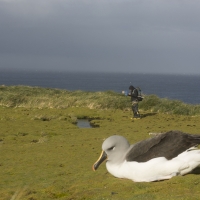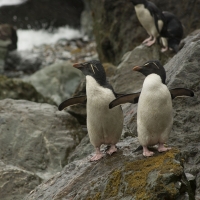Diego Ramirez - Drake Passage Marine Park is now a reality.
January 23, 2018
On January 22, 2018, the government of Chile approved the creation of the Diego Ramirez - Drake Passage Marine Park.
It will encompass an area of 140 thousand km2 of land and marine habitats of the Diego Ramirez archipelago, at the southern end of the continental shelf of the American continent, which provides a unique refuge for the protection of threatened and endangered species like the Grey-headed albatross and southern rockhopper penguins. This decree also grants legal protection to the submerged continental escarpment that dramatically drops into the Drake Passage off the southern coast of Chile, as well as the South Pacific Ocean's most important underwater mountain, Sars Seamount.
Dr. Ricardo Rozzi, Director of the Sub-Antarctic Biocultural Conservation Program, who has led the technical-scientific proposal for the creation of the marine park, said that "this event marks a milestone in marine conservation for the country and the planet because it integrates the regional, national, and international scales to harmonize environmental sustainability with economic and social sustainability. Its design does not adversely affect artisanal fishing practices, generates synergy with tourism of special interests, and generates an innovative approach to industrial fishing practices. The establishment of this park represents a milestone since it proposes an innovative model that overcomes dichotomies between conservation and development."
The team of researchers and professionals at the Sub-Antarctic Biocultural Conservation Program (SBCP), led by the University of Magallanes in Chile and the University of North Texas in the United States, took particular care to ensure the marine park integrated the conservation of the area with the existing economic activities. The SBC Program is committed to President Bachelet's vision of conservation and fulfillment of long-term research, monitoring the impact of global warming on sub-Antarctic biodiversity. Additionally, it shares the researchers' findings through educational programs and the transfer of knowledge to the local community and the private sector, in order to promote sustainable practices in the Cape Horn region.
To this end, the SBC Program has actively collaborated with national and regional government agencies and with the Cape Horn municipality to implement the Management Plan for the Marine Park, which is now the largest marine protected area in southern South America, just north of Antarctica. Also involved are an alliance of Chilean academic centers led by the Institute of Ecology and Biodiversity and the P. Catholic University of Chile, as well as international programs led by the University of North Texas. This consortium has established an academic platform, which will be strengthened by the new Sub-Antarctic Cape Horn Center that will be built in Puerto Williams this year. The Center, along with the declaration of protections for the Diego Ramirez - Drake Passage Marine Park, are examples of advances that will work to successfully overcome challenges associated with the aim of achieving long term sustainability for the sub-Antarctic region and the planet.
"This marine park will be implemented in collaboration with the Chilean Navy, the Ministry of National Assets, the Ministry of Environment, the Ministry of Economy, and the Regional Government, integrating a multiple-dimensional concept of sustainability to confront current, challenging times of socio-environmental change global," concluded Rozzi.
Read more about the Park in this article in La Prensa Austral.


Images by Omar Barroso